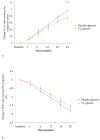Effect of Violet Light-Transmitting Eyeglasses on Axial Elongation in Myopic Children: A Randomized Controlled Trial
- PMID: 34830743
- PMCID: PMC8624215
- DOI: 10.3390/jcm10225462
Effect of Violet Light-Transmitting Eyeglasses on Axial Elongation in Myopic Children: A Randomized Controlled Trial
Abstract
The fact that outdoor light environment is an important suppressive factor against myopia led us to invent violet light-transmitting eyeglasses (VL glasses) which can transmit violet light (VL), 360-400 nm in wavelength, for the suppression of myopia, and can meanwhile block harmful ultraviolet waves from sunlight. The current study is a double-blinded randomized clinical trial to investigate the myopia-suppressive effect of VL glasses compared to conventional eyeglasses (placebo glasses) that do not transmit VL. The subjects were children aged from 6 to 12 years old, the population in which myopia progression is generally accelerated, and the myopia suppressive effect was followed up for two years in a city in Japan. Periodical ophthalmic examinations, interviews, and measurements of reflection and axial length under mydriasis were performed at the initial visit (the baseline) and at 1, 6, 12, 18, and 24 months. The mean change in axial length in the VL glasses group was significantly smaller than in the placebo glasses group when time for near-work was less than 180 min and when the subjects were limited to those who had never used eyeglasses before this trial (p < 0.01); however, this change was not significant without subgrouping. The suppressive rate for axial elongation in the VL glasses group was 21.4% for two years.
Keywords: axial length; double blinded randomized controlled trial; eyeglasses; myopia; myopia control; refraction; violet light.
Conflict of interest statement
Tsubota laboratory, Inc., for which Kazuo Tsubota works as the Chief Executive Officer (CEO), receives distribution royalty fees for selling the lenses used in this study from JINS HOLDINGS, Inc., a sponsor of this research.
Figures



References
-
- Bikbov M.M., Gilmanshin T.R., Kazakbaeva G.M., Zainullin R.M., Rakhimova E.M., Rusakova I.A., Bolshakova N.I., Safiullina K.R., Zaynetdinov A.F., Zinatullin A.A., et al. Prevalence of Myopic Maculopathy Among Adults in a Russian Population. JAMA Netw. Open. 2020;3:e200567. doi: 10.1001/jamanetworkopen.2020.0567. - DOI - PMC - PubMed
-
- Bikbov M.M., Kazakbaeva G.M., Rakhimova E.M., Rusakova I.A., Fakhretdinova A.A., Tuliakova A.M., Panda-Jonas S., Gilmanshin T.R., Zainullin R.M., Bolshakova N.I., et al. Prevalence Factors Associated With Vision Impairment and Blindness Among Individuals 85 Years and Older in Russia. JAMA Netw. Open. 2021;4:e2121138. doi: 10.1001/jamanetworkopen.2021.21138. - DOI - PMC - PubMed
LinkOut - more resources
Full Text Sources

